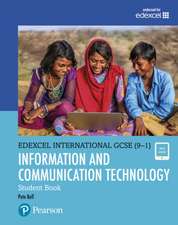Cambridge IGCSE™ and O Level Geography Coursebook with CD-ROM: Cambridge International IGCSE
Autor Gary Cambers, Steve Sibleyen Limba Engleză Mixed media product – 6 mar 2018
Din seria Cambridge International IGCSE
-
 Preț: 249.60 lei
Preț: 249.60 lei -
 Preț: 114.16 lei
Preț: 114.16 lei -
 Preț: 91.38 lei
Preț: 91.38 lei -
 Preț: 140.24 lei
Preț: 140.24 lei - 8%
 Preț: 546.82 lei
Preț: 546.82 lei -
 Preț: 211.58 lei
Preț: 211.58 lei -
 Preț: 301.93 lei
Preț: 301.93 lei -
 Preț: 232.85 lei
Preț: 232.85 lei -
 Preț: 218.19 lei
Preț: 218.19 lei -
 Preț: 414.24 lei
Preț: 414.24 lei -
 Preț: 250.68 lei
Preț: 250.68 lei -
 Preț: 128.73 lei
Preț: 128.73 lei -
 Preț: 347.04 lei
Preț: 347.04 lei -
 Preț: 161.04 lei
Preț: 161.04 lei -
 Preț: 240.49 lei
Preț: 240.49 lei -
 Preț: 258.62 lei
Preț: 258.62 lei -
 Preț: 111.95 lei
Preț: 111.95 lei -
 Preț: 145.49 lei
Preț: 145.49 lei -
 Preț: 125.99 lei
Preț: 125.99 lei -
 Preț: 101.58 lei
Preț: 101.58 lei -
 Preț: 127.04 lei
Preț: 127.04 lei -
 Preț: 328.55 lei
Preț: 328.55 lei -
 Preț: 324.73 lei
Preț: 324.73 lei -
 Preț: 116.52 lei
Preț: 116.52 lei -
 Preț: 192.41 lei
Preț: 192.41 lei -
 Preț: 298.71 lei
Preț: 298.71 lei -
 Preț: 93.60 lei
Preț: 93.60 lei -
 Preț: 80.01 lei
Preț: 80.01 lei -
 Preț: 241.30 lei
Preț: 241.30 lei -
 Preț: 129.66 lei
Preț: 129.66 lei -
 Preț: 167.06 lei
Preț: 167.06 lei - 9%
 Preț: 628.30 lei
Preț: 628.30 lei -
 Preț: 89.90 lei
Preț: 89.90 lei -
 Preț: 96.14 lei
Preț: 96.14 lei -
 Preț: 90.96 lei
Preț: 90.96 lei -
 Preț: 267.40 lei
Preț: 267.40 lei -
 Preț: 116.97 lei
Preț: 116.97 lei -
 Preț: 437.36 lei
Preț: 437.36 lei -
 Preț: 93.16 lei
Preț: 93.16 lei -
 Preț: 94.21 lei
Preț: 94.21 lei - 9%
 Preț: 847.69 lei
Preț: 847.69 lei -
 Preț: 414.66 lei
Preț: 414.66 lei -
 Preț: 256.25 lei
Preț: 256.25 lei -
 Preț: 182.63 lei
Preț: 182.63 lei -
 Preț: 129.02 lei
Preț: 129.02 lei -
 Preț: 130.29 lei
Preț: 130.29 lei -
 Preț: 289.21 lei
Preț: 289.21 lei -
 Preț: 432.86 lei
Preț: 432.86 lei -
 Preț: 129.87 lei
Preț: 129.87 lei
Preț: 244.91 lei
Nou
Puncte Express: 367
Preț estimativ în valută:
46.88€ • 50.94$ • 39.40£
46.88€ • 50.94$ • 39.40£
Carte disponibilă
Livrare economică 01-15 aprilie
Livrare express 15-21 martie pentru 41.20 lei
Preluare comenzi: 021 569.72.76
Specificații
ISBN-13: 9781108339186
ISBN-10: 1108339182
Pagini: 304
Dimensiuni: 220 x 276 x 17 mm
Greutate: 0.81 kg
Ediția:2Revizuită
Editura: Cambridge University Press
Colecția Cambridge University Press
Seria Cambridge International IGCSE
Locul publicării:Cambridge, United Kingdom
ISBN-10: 1108339182
Pagini: 304
Dimensiuni: 220 x 276 x 17 mm
Greutate: 0.81 kg
Ediția:2Revizuită
Editura: Cambridge University Press
Colecția Cambridge University Press
Seria Cambridge International IGCSE
Locul publicării:Cambridge, United Kingdom
Cuprins
Part A. Geographical Themes: World map; Theme 1. Population and Settlement: 1. World population increase; 2. Over-population and under-population; Case Study. Over-population–Nigeria; Case Study. Under-population–Australia; 3. Causes of a change in population size; 4. Population change; Case Study. High rate of natural population growth–Niger; Case Study. Population decline–Russia; 5. Population policies; 6. Population migration; 7. The impacts of migration; Case Study. An international migration–Qatar; 8. Finding out about the population; Case Study. A country with high dependency–Italy; 9. Factors influencing population density; Case Study. High population density–Japan; Case Study. Low population density–Namibia; 10. Settlement patterns; 11. Settlement sites, growth and functions; 12. Settlement hierarchy; Case Study. Settlement and service provision in Sardinia; 13. Urban land use; 14. Urban problems and solutions; Case Study. An urban area–Atlanta; 15. Rapid urban growth; 16. Impacts of urban growth; Case Study. Urbanisation in Peru–Lima; Exam-style questions; Global Theme 1. HIV/AIDS; Theme 2. The Natural Environment: 17. Types and features of earthquakes and volcanoes; 18. Plate tectonics; 19. Causes and effects of earthquakes and volcanoes; 20. Volcanoes present hazards and opportunities; 21. Reducing the impacts; Case Study: An earthquake–Haiti; Case Study. A volcano–Mount Sinabung; 22. Rivers and drainage basins; 23. The work of rivers; 24. River landforms 1; 25. River landforms 2; 26. Rivers–hazards and opportunities; 27. Managing river flooding; Case Study. The Elbe River; 28. The work of the sea; 29. Coastal landforms created by erosion; 30. Coastal landforms created by deposition; 31. Coral reefs and mangrove swamps; 32. Hazards and opportunities; 33. Managing coastal erosion; Case Study. An area of coastline–Mauritius; 34. Collecting weather data 1; 35. Collecting weather data 2; 36. Using weather data; 37. Using weather and climate data; 38. The equatorial climate; 39. Tropical rainforest ecosystems; 40. Rainforest deforestation; Case Study. The tropical rainforest–Ecuador; 41. Hot desert climates; 42. Hot desert ecosystems; Case Study. A hot desert–the Sahara and Mali; Exam-style questions; Global Theme 2. Reducing Carbon Emissions; Theme 3. Economic Development: 43. Indicators of development; 44. Identifying inequalities; 45. Classifying production; 46. Employment structure varies; 47. Globalisation; Case Study. A trans-national corporation–Nokia; 48. Agricultural systems; Case Study. An arable farm in Lincolnshire; 49. Food shortages; Case Study. Food shortages in Darfur, Sudan; 50. Industrial systems; 51. Industrial location; Case Study. The Pakistan steel complex at Pipri; 52. The growth of tourism; 53. The benefits and disadvantages of tourism; 54. Managing Tourism for sustainability; Case Study. An area where tourism is important–Dubai, UAE; 55. Energy use varies; 56. Nuclear power or renewables; Case Study. Energy supply in Iceland; 57. Using water; 58. Managing water; Case Study. Water supply in Lesotho; 59. Economic activities pose threats; 60. Managing sustainable development; 61. Conserving natural resources; Case Study. Fracking in California; Exam-style questions; Global Theme 3. Reduce, reuse, recycle; Part B. Geographical Skills: 1. 1:50 000 Monsefu, Peru; 2. 1:50 000 Harare, Zimbabwe; 3. 1:25 000 North York Moors, UK; 4. 1:25 000 Montego Bay, Jamaica; 5. 1:25 000 Negara, Indonesia; 6. 1:50 000 Leicester, UK; Exam-style questions; Map skills checklist; Part C. Geographic Enquiry: Fieldwork skills examinations; 1. Investigating the CBD; 2. Investigating rivers; 3. Investigating tourism; 4. Investigating weather; Fieldwork checklist; The alternatives to coursework; Exam-style question 1; Exam-style question 2; Part D. Preparing for Examinations: Geographical themes: Case studies; Geographical skills; Alternative to coursework/Geographical investigation; Resource
Descriere
Cambridge IGCSE and O Level Geography has been written specifically for Cambridge International syllabuses 0460 and 2217.














